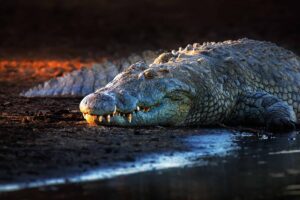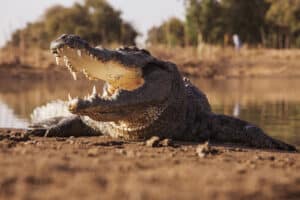In the dramatic video below, a giant crocodile attacks a smaller one. The attacker bites its prey on the back. The other swings its head around to fight back. The larger of the two lunges for the smaller one’s tail and chomps down hard!
Then it goes into a death roll. This won’t be an easy meal, though. The smaller crocodile fights back fiercely and finally manages to get loose. It swims away frantically, and the bigger crocodile lets it go. There won’t be any cannibalism today!
This incredible scene is not unheard of among crocodiles. Cannibalism is common among these creatures, along with fighting over resources and killing each other.
Watch the Crocodile Drama Unfold Below!
Is it Normal for Giant Crocodiles to Eat Smaller Ones?

Crocodiles often fight over territory, food, and mating.
©dangdumrong/Shutterstock.com
Yes! In the world of crocodilians, survival of the fittest is key. The bigger and stronger they are, the better chances of survival they have. Crocodilia is an order which describes a group of animals that includes all species of crocodiles, alligators, caimans, and gharials. An order is a class of animals grouped together based on their similar characteristics. A single member of Crocodilia is referred to as a crocodilian. The order is further broken down into family, genus, and species. Cannibalism, or killing and eating their own kind, is common in all species of this order.
When young crocodilians hatch, most immediately crawl toward the water to swim out on their own. Sometimes, the babies will stick together for a while in hopes there is safety in numbers. In a few species, the mother will carry them to the water. Entering waterways with their larger family members puts them at risk of being eaten. These creatures are opportunistic feeders, which means they will eat pretty much anything they can catch. Babies are an easy meal for a giant crocodile, just like the one in this video. This cannibalistic behavior ensures that only the fastest and smartest of the babies makes it to adulthood.
Crocodilians also fight with one another over territory, food, and mating opportunities. This is called survival of the fittest. The strongest of the species are able to feed themselves, control territory, and pass on their genetics to the next generation. It’s a croc-eat-croc world out there!
Are Crocodiles the Only Cannibalistic Animals?

Praying mantis females cannibalize their mates after breeding.
©Warren Parker/Shutterstock.com
No! Besides crocodiles, other animals are known to eat their own kind. Many of these instances occur after mating. Sometimes, there is just not enough food around. Other times, a mother realizes something is wrong with her baby. She will kill it to end its suffering and eat it to protect her other babies from predators. There are actually many animals that eat their young!
Insects and Spiders
The females of many spider and insect species devour their mates after the deed is done. This is because the female needs the nutrients from the male in order to raise her young. Sometimes, this is the last meal she will eat before her babies arrive and then consume her! Some of these species include praying mantis, black widow spiders, and scorpions.
Other Reptiles
There are reptiles that cannibalize their young or their mates, other than crocodiles. For example, green anaconda females mate with many males all at once in what is called a “breeding ball.” When mating is successful, she has a long pregnancy ahead. Her movement slows down, and she finds it more difficult to move. She will eat a few of the males to get much-needed nutrition rather than wasting energy hunting. Anacondas are one of the few snake species that give live birth!
Mammals
Some mammals are cannibalistic, as well. Many times, this is due to a lack of available food. Other times, it is due to something being wrong with the baby. An example of this is when a domestic cat kills and eats a baby who has a deformity. While unpleasant to think about, it prevents the baby from living a short, miserable life. Eating the body prevents the smell of blood and death from traveling and leading a predator to the den. It also allows the mother to care for the other young more easily.
Octopuses
Perhaps the most interesting example of animal cannibalism is the octopus. The females are known to eat their mates after breeding. The mother will then lay her eggs and protect them at all costs. Strangely, she will actually stop eating during this process. The mother dies of starvation before the babies are even born. They then eat her body as their first meal!
The photo featured at the top of this post is © diegooscar01/Shutterstock.com
Thank you for reading! Have some feedback for us? Contact the AZ Animals editorial team.






